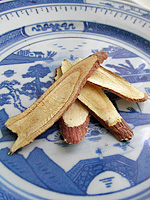|
 |
| Gan Cao |
| |
|
| Name |
Latin Name: Radix Glycyrrhizae
Common Name: Liquorice root / licorice
Scientific Name: Glycyrrhiza uralensis Fisch.
Chinese Name: 甘草
Pinyin Name: gan cao |
| Top |
|
| Origin |
|
The root of Glycyrrhiza uralensis Fisch., Glycyrrhiza inflata Bat. and Glycyrrhiza glabra L., perennial plants of the Leguminosae family. The medicinal part is used in raw form or roasted with honey. [1], [3] |
| Top |
|
| Where Does It Grow? |
| Liquorice root is mainly produced in Inner Mongolia, Gansu, Xinjiang, and western region of Northeast China. [2] |
| Top |
| Nature and Flavor |
| Liquorice root is sweet in flavor, neutral in nature and manifests its therapeutic actions in the spleen, stomach, heart and lung meridians. [3] |
| Top |
|
| Identified Active Components/ Major Chemical Constituents |
| Liquorice root contains glycyrrhizin and many flavones, such as liquiritin, neoliquirtin, isoliquiritin and isoliquiritigenin. Also hydrolytes such as glucuronic acid and glycyrrhetinic acid. |
| Top |
|
| Drug actions in TCM |
| Liquorice root replenishes qi (vital energy), facilitates spleen and stomach functioning, clears heat, eliminates toxic substance, expels phlegm, controls coughing, slows down acute reactions, stops pain and modulates the harsh properties of other herbs. [3] |
| Top |
|
| Traditional Uses in TCM |
|
Liquorice root is often used in conditions like spleen and stomach deficiencies, general weakness, palpitations, breath shortness, productive coughs, spasms in gastric and abdominal regions and limbs, running sores, abscess and poisoning. [3], [4]
 |
Liquorice root replenishes qi (vital energy), facilitates spleen and stomach functioning. Spleen and stomach deficiencies lead to a low level of qi, which makes individuals develop fatigue, general weakness, poor appetite and loose bowels, liquorice root can work with pilose asiabell root, largehead atractylodes rhizome and poria for relief. Persistent spleen weakness may result in insufficient qi to hold the internal organs in their proper places, prolapse of the anus or other organs will then develop, which can be treated by liquorice root combining with astragalus root, bupleurum root and bugbane rhizome. |
 |
Liquorice root is used in a variety of cough conditions. The herb can work with ephedra and bitter apricot kernel to treat wind-cold cough; gypsum, pinellia tuber and poria to treat phlegm-dampness cough; snake gourd and unibract fritillary bulb to treat phlegm-heat cough; fourleaf ladybell root and dwarf lily-turf tuber to treat yin deficiency cough; gypsum, ephedra and bitter apricot kernel to treat heat cough and panting; dried ginger, Manchurian wildginger and schisandra to treat cold cough and panting. |
 |
Liquorice root is used in muscular spasms. The herb can combine with white peony root, angelica root and suberect spatholobus stem to relieve muscular spasms that due to blood deficiency; cassia twig, peony root and fresh ginger to relieve abdominal colic that due to excessive coldness in the spleen and stomach. |
 |
Liquorice root is often used to modulate undesirable harshness or toxic properties in the remedies. For example, the herb is added in purgative remedies, so as to reduce the adverse effects of rhubarb and sodium sulfate, such as abdominal pain. It often acts as a buffer to harmonize different ingredients in a remedy, and may also be a sweetening to make the decoction easy to drink. |
 |
Liquorice root can promote the healing of pus-forming infections or inflammatory conditions. In dermatitis or boils, liquorice root can combine with honeysuckle flower, weeping forsythia capsule and dandelion for internal and external treatments. The herb can work with platycodon root to relieve sore throat. |
 |
Processed liquorice root is an important ingredient for palpitation and abnormal heart beating, which TCM regards as the signs of inadequate blood and qi in the heart. The herb is usually prescribed with ginseng, donkey-hide gelatin, cassia twig and rehmannia root to replenish blood and qi in the heart. |
 |
In TCM, hysteria is an emotional disorder that due to heart weakness or liver stagnation, physicians will use liquorice root, shriveled wheat and Chinese date as the basic ingredients, and then combine other ingredients to treat individual conditions accordingly. |
 |
Liquorice root can be used to detoxify. For mild poisoning and there is no available antidote, physicians may try to alleviate it by a concentrated solution of liquorice root. The herb can be used alone, or boiled with mung bean, black soybean or honey. |
Modern TCM also uses liquorice root to treat Addison's disease, peptic ulcer, viral hepatitis, thrombocytopenic, purpura, diabetes insipidus, eczema, herpetic keratitis, scleritis and acute iridocyclitis.
|
| Top |
|
| Pharmacological Actions |
|
|
| Top |
|
| Administration and Dosage |
| For decoction, 2-6g each time, dosage should be low when using for modulation. As a main ingredient, the herb should be used in high dose such as around 10g each time, and 30-60g for detoxification. Processed liquorice root is recommended for invigoration or replenishment; raw form is recommended for cleansing and detoxification. [5] |
| Top |
|
| Adverse Effect, Side Effects and Cautions |
| Liquorice root is contraindicated for individuals with nausea, chest stuffiness, abdominal distention and general swelling. When raw liquorice root is used improperly and for a long time, there will be side effects like puffiness and hypertension. [5] |
| Top |
|
| References |
| 1. |
李家實主編《中藥鑒定學》上海科學技術出版社, 2000年2月. |
|
|
| 2. |
趙中振主編《香港中藥材圖鑑》香港浸會大學中醫藥學院,2004年6月. |
|
|
| 3. |
雷載權主編《中藥學》上海科學技術出版社, 2000年6月. |
|
|
| 4. |
陶御風編著《臨証本草》人民衛生出版社,2005年5月. |
|
|
| 5. |
http://www.zysj.com.cn/zhongyaocai/yaocai_g/gancao.html |
|
| Top |
|
|
|